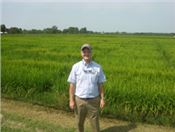|
Irrigation Tools Simplify Cotton Watering Decisions

Dr. Gene Stevens, Extension Professor-Cropping Systems Specialist, University of Missouri-Fisher Delta Research Center in Portageville, Mo.
spoke recently encouraging farmers to maximize irrigation efficiency in fields to reduce input costs,
conserve water resources, and minimize nutrient runoff to streams.
Photo by Jack Thompson
BETTY VALLE GEGG-NAEGER
MidAmerica Farmer Grower
“Water is an important management factor for row crop production, especially in regions where irrigation is applied to supplement rainfall,” said Dr. Gene Stevens, Extension Professor-Cropping Systems Specialist, University of Missouri-Fisher Delta Research Center in Portageville, Mo. Stevens spoke at the 21st Annual National Conservation Systems Cotton & Rice Conference recently in Memphis.
Farmers are encouraged to maximize irrigation efficiency in fields to reduce input costs, conserve water resources, and minimize nutrient runoff to streams.
In the central United States, the climate is humid but periods of low rainfall are common in the summer months when crops are growing. Irrigation is often applied in fields to prevent water stress and increase crop yields. Irrigation scheduling programs are useful tools for improving water efficiency. Several state extension services have developed mobile phone apps linked to electronic weather station networks to calculate evapotranspiration (ET) used for irrigation scheduling.
“Obtaining daily data is a challenge for farms located outside weather station networks. In a two-year study, we compared electronic atmometers (ETgages) to weather stations. The ETgages showed good accuracy at one-tenth the cost of a station for supplying daily ET estimates,” he noted.
Most state extension irrigation apps use the same algorithms to calculate daily soil water balances. The complex calculations mentioned are “behind the scenes” in most irrigation apps. The Penman-Monteith equation is often used to estimate standardized short-grass evapotranspiration called ETo. The first version was developed in 1948 by Howard Penman and other engineers have continued to fine-tune it over the years. It has become the “gold standard” for irrigation management around the world.
ET is the combination of transpiration from the crop and evaporation of the water from the soil or plant surfaces. The University of Missouri Extension Service maintains an agricultural weather station network (mesonet) which provides weather data to farmers for managing irrigation. The weather stations must meet standards approved by the American Society of Agricultural Engineers. Most of the 34 stations in the mesonet have a Campbell Scientific™ CR-1000 data logger which is programmed to calculate standardized short-grass evapotranspiration called ETo. For farmers calculating daily crop ET for irrigation scheduling, ETo is multiplied by a coefficient (Kc) specific to the crop in the field. In the Northern Hemisphere, ETo is usually highest in June, and July when days are longer. ETo varies from year to year which is a limitation for irrigation scheduling from printed charts that rely on long-term weather averages.
“Farmers do not have time to manually calculate daily crop ET and soil water deficits from weather data for their fields,” Stevens said. “The main difference between extension irrigation apps is their interface design and ease of use. Growers usually just want to know which fields on their farm needs irrigation today or the coming week. Predictions such as crop growth from temperature are important but secondary.”
In 2015, the University of Missouri Extension Service released an irrigation app for mobile phones called the Crop Water Use app which uses daily ETo from the state mesonet. Many of the equations in the Missouri program including crop coefficients were modified from the Arkansas Irrigation Scheduler. Lack of ETo data is a limitation for farmers wanting to use these apps for irrigation scheduling. Some states in the region have mesonets, but do not calculate ETo, while other states are data sparse when it comes to the number of weather stations that do calculate it.
One of the largest systems for sharing weather data among universities and government agencies operates in the Western region. The Irrigation Scheduler Mobile phone app developed at Washington State University accesses ETo from AgriMet-Pacific Northeast, a group of 270 weather stations maintained by the Bureau of Reclamation, and mesonets in Washington, Montana, Colorado, Arizona, North Dakota, South Dakota, and California. Many stations are federally supported. In the eastern United States, most of the agricultural weather stations are purchased and maintained at the state level.
Irrigation frequency is impacted by the app setup settings by the farmer. In the Missouri program, soil available water holding capacity, rooting depth and percent allowable depletion determine the irrigation trigger. Fields with sandy soils with low available water holding capacity trigger faster and need smaller amounts of irrigation water more frequently than medium textured soils.
“In cotton field trials on silt loam soil, we found that setting the rooting depth at 18 inches produced the highest lint yields in 2016,” he said.
A second opinion in crop management decisions is a good idea. Soil moisture sensors are being used in conjunction with a water balance app to get another source of information for making irrigation decisions.
“In 2017, we tested Watermark soil moisture sensors in a cotton field with the Irromesh™ telemetry system,” Stevens continued. “Sensors were placed at two soil depths in cover crop/tillage plots. Early in the season, we had problems associating nodes in the plots to the receiver at the base station. After the technical problems were worked out, we were able to download “spaghetti string” soil water graphs from the internet with an office computer. Daily soil water potentials changed with rainfall and irrigation events but sensor to sensor variability was high within the same treatments.”
To download the University of Missouri Crop Water Use app, go to cropwater.org. “If you are in another state and you want to use this app, we will work with you,” Stevens summed. ∆
BETTY VALLE GEGG-NAEGER: Senior Staff Writer, MidAmerica Farmer Grower
|
|